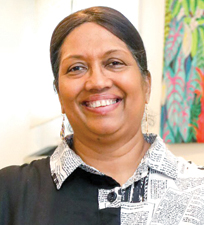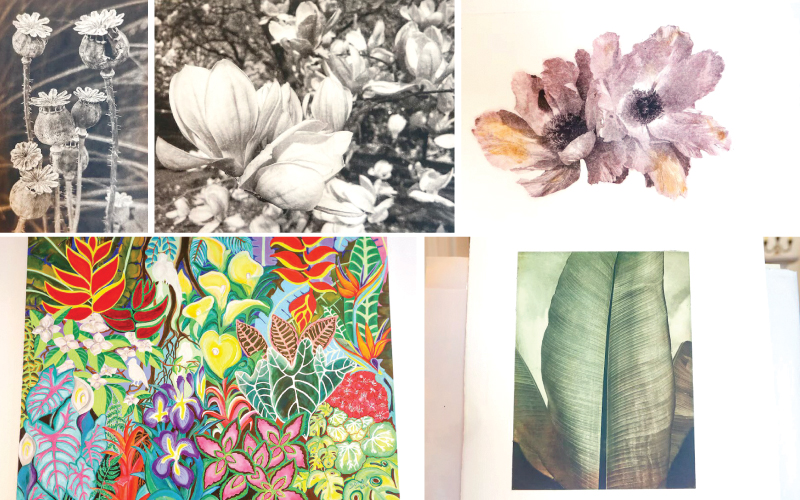Thirty years ago, Dona Geethani Kiriella finished her Bachelor of Fine Arts degree in Sculpture in Sri Lanka’s only visual and performing arts university — then a year later, at 25, she got married and journeyed to America.
“I was an art teacher back home before I came here. We had to start from the beginning here because we are first generation immigrants, so I had no choice than to do whatever I had to do,” she said.
Today, Dona Kiriella’s home in Mariners Harbour, where she resides with her son, daughter, and husband, is adorned with vibrant paintings of flowers. After making sculptures, Catholic art centred on the Crucifixion of Christ, and portraits for years in Sri Lanka, she shared that she started painting flowers during the coronavirus pandemic in 2020. During this time, she observed spring coming into full bloom at Silver Lake Park and Snug Harbor Cultural Center, where she spent most of her time during quarantine.

Geethani Kiriella
“That was the only place I could go. I spent so much time walking out in the park,” she said. “I passed through the seasons and saw how the poppy flowers grow. I thought, ‘how beautiful.’”
However, she recounted that when she entered her floral artwork for a collaborative exhibition in Sri Lanka last year, featuring a collective of seven artists from her alma mater, they did not resonate with her vibrant and simple nature-inspired pieces. “In Sri Lanka, we only have one established performing arts college,” Kiriella said. “As an artist in Sri Lanka, the theme is always political nowadays. So, they wanted more of that kind of art. They are very politically and economically tired.”
The University of the Visual and Performing Arts is Sri Lanka’s only institution established to provide undergraduate and postgraduate education exclusively in the subject streams of visual and performing arts, as well as conducting related research.
As a South Asian woman, Kiriella shared how the resistance to her artwork made her realise that the Asian artistic perspective tends to be more analytical, which clashed with her simplistic style.
“They want to use art as a weapon to give a message,” she said.
Group exhibition
In September 2023, through persistence, hard work, and the support of her university professor, Kiriella’s vibrant and simple flower artworks were featured in the group exhibition titled “Impulses,” presented under the theme “Simplicity of Nature.”
Her pieces shared space with the works of fellow collective members, highlighting various themes such as women’s struggles in garment factories and living with the fear of sexual assault.
“But I do not want to make art that makes people unhappy and depressed because we have that. I want to make somebody happy and even if it is for a few minutes, give happiness,” she said.
She said that her artwork, including her collection of photopolymer art, ended up receiving tremendous appreciation at the exhibition. She also performed a live art demonstration, showcasing printmaking under the sun using photopolymer plates, which amazed the audience as it is a novel technique and not widely known in the area.
Every couple of years, Kiriella returns to Sri Lanka to collaborate with local artists on joint exhibitions.
After she settled on Staten Island in 1995, home to the most significant Sri Lankan population outside Sri Lanka, Kiriella worked many jobs throughout the years — she worked as a house cleaner, babysitter, laundromat employee, and at one point, she also served as an elderly caregiver.
“I was an elderly caregiver for a 93-year-old multi-millionaire who lived on Fifth Avenue by Central Park,” she said. “His ex-girlfriend, Georgia O’Keeffe, was one of the most famous artists in America. He had a bachelor’s degree in art, and his sister was an art collector. My job was to go to his home, make him breakfast, and take him to exhibitions because he was really into art.”
She remembers those 1996 times fondly because she enjoyed looking at art and talking about it with people from the art world in New York, she said. “I had time to look at art and analyse and critique it. That is the only time I was so happy at work,” she said. Following her time in that job, she devoted herself to raising her two children until they reached an age where she had more time to dive back into the art world.
Printmaking journey
In 2007, Kiriella continued her artistic and academic journey by earning a Master’s degree in printmaking from City University of New York, Lehman College. Later, in 2016, she completed her Master of Philosophy (M.Phil.) in art history, specialising in printmaking.
Over the past few years, she has contributed cartoons to a newspaper named Lanka Post. She has also illustrated children’s books written by her son, Don J Kiriella, including The Bullied Tomato and The Little Cashew Nut.
Today, she also serves the Sri Lankan and broader Asian communities on Staten Island through her work as Vice President of the Asian American Labor and Community Organization (AALCO). AALCO’s mission is to promote the well-being and rights of Asian labour and community members in the USA, fostering harmonious relations and advocating for fair treatment and tolerance.
“It is certainly not easy to find printmaking jobs here,” she said. “I do not want to say it, but it is a dead art form. Nobody wants to do it because it is a long process. You have to have patience and in the 21st Century, nobody really has patience.”
Printmaking is an artistic technique that transfers images from a matrix onto various surfaces, such as paper, fabric, wood and metal. It enables artists to produce multiple original works of art.
Kiriella is embarking on a journey to earn a Ph.D. in art history. Her goal is to research methods to make printmaking cheaper and environmentally sustainable.
“My Ph.D. will be about non-toxic printmaking. I want to introduce to Sri Lanka some kind of method to do printmaking without toxins. I want to help invent an easy way to do printmaking there. I do not know how yet,” she said.
She is collaborating with Dan Weldon, a master printmaker with 40 years of experience and a pioneer in alternative printmaking, to create plates at a more affordable price for use in Sri Lanka. She aspires to eventually introduce eco-friendly printmaking practices to Sri Lanka and South Asia and inspire innovation.
“I do not know how far I can go,” she said. “But we cannot simply let that art form die.”
(Staten Island Live)









